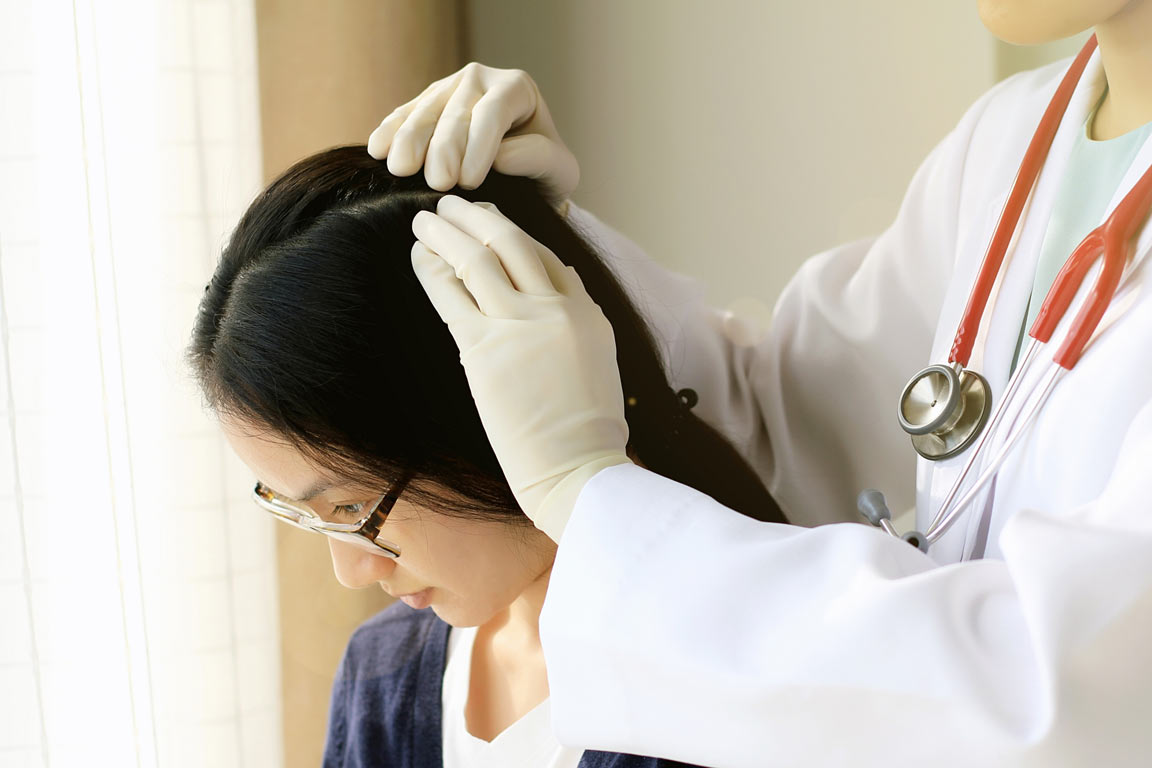Can Seborrheic Dermatitis Cause Hair Loss?
- Causes of Seborrheic Dermatitis
- Conventional Treatments for Seborrheic Dermatitis
- Natural Treatment Options for Scaly Scalp Conditions

Seborrheic dermatitis is a common chronic inflammatory scaling eczema rash of the scalp. Although it is an inflammatory skin rash, seborrheic dermatitis overlaps with non-inflammatory dandruff. The appearance can range from greyish white scales throughout the scalp as seen in dandruff to yellow to reddish thick crusty patches. In severe cases it can directly cause hair loss on the scalp. In cases where the rash is itchy, scratching can cause hair loss or make it worse.(21, 22, 74, 76)
Symptoms and microscopic indicators of seborrheic dermatitis are also very similar to other skin conditions, including:(22, 76)
- Contact dermatitis
- Pityriasis amiantacea
- Psoriasis
- Tinea capitis
Initial diagnosis can be difficult between all these conditions—although psoriasis is typically more inflammatory and likely to extend beyond the scalp hairline. However, evidence suggests that seborrheic dermatitis may be a pre-psoriatic condition in some people.(22, 76)
Causes of Seborrheic Dermatitis
In both dandruff and seborrheic dermatitis, the presence of Malassezia furfur yeasts are present on the scalp, but the relationship to the yeasts is not clear since people without the disorders also have these yeasts present. Nevertheless, when either one is treated with antifungal agents the yeast is reduced and symptoms subside, and when the yeast recolonizes the symptoms recur.(22, 76)
Other conditions that seborrheic dermatitis is either a symptom of or triggered by include:(22, 76)
- Facial paralysis
- HIV and AIDS
- Niacin deficiency
- Parkinson's disease
- Seasonal flare-ups similar to seasonal allergies
- Stress
- UV-radiation aggravated dermatitis with evidence of micro-inflammation
- Zinc deficiency
These suggest that a poor diet and suppressed immune system status either cause or contribute to the development of seborrheic dermatitis. Many are also associated with telogen effluvium and even scarring alopecia.(59, 76)
In addition, topical minoxidil (used as a hair loss treatment) can make seborrheic dermatitis worse. Elderly people can also be at greater risk for developing the rash due to infrequent shampooing. However, although external factors can aggravate seborrheic dermatitis, it is considered to be an endogenous eczema caused by internal factors, including genetics.(13, 21)
Conventional Treatments for Seborrheic Dermatitis
Traditional medical therapies to manage symptoms include:
- Itraconazole 100—systemic compound for less-severe cases(76)
- Ketoconazole—a synthetic antifungal used in topical creams or shampoos; available in over-the-counter strengths and 2% concentration by prescription(76)
- Pimecrolimus (1%) cream(76)
- Salicylic acid ointment(22)
- Selenium sulfide, pyrithione zinc, and tar shampoos(76)
- Sodium sulfacetamide topical ointment—inhibits bacterial growth(76)
- Steroidal creams (such as 1-2.5% hydrocortisone) for more severe cases(76)
- Sulfur precipitate (3%) combined with 2% salicylic acid (prescription; topically applied)(76)
- Systemic 13- cis retinoic acid (1-mg/kg dosages) in severe cases(76)
- Tacrolimus (0.03%) ointment(76)
- Tar ointment(22)
Tar and salicylic acid ointments are left on for a few hours. After washing, scales can be gently scraped out with a metal comb. Most treatments will need to be repeated because of flare-ups.(22)
Natural Treatment Options for Scaly Scalp Conditions
Topical and oral supplements of certain vitamins may help treat seborrheic dermatitis. Herbal remedies for seborrheic dermatitis include essential oils proven effective (in varying degrees) as both antifungal and antibacterial topical agents.
| HERBAL TREATMENT OPTIONS FOR SCALY SCALP CONDITIONS | |
|---|---|
| AGENT | RECOMMENDATIONS ON USE & EVIDENCE OF BENEFIT |
| Aloe (Aloe vera) |
Question: Can aloe treat seborrheic dermatitis? Answer: Placebo-controlled cases show topical aloe (0.5%) is effective at treating scaly skin rashes.(66) |
| Arnica (Arnica Montana) |
Question: What's the best way to use arnica for seborrheic dermatitis? Is arnica safe to use? Answer: Experts recommend using an ointment that contains a minimum 15% concentration of arnica to treat seborrheic dermatitis. Arnica is generally safe to use topically, but experts advise the following precautions:(66)
|
| Biotin |
Question: Can biotin treat seborrheic dermatitis? What is the best biotin dose for seborrheic dermatitis? Answer: Biotin supplements (1-10 mg/day) can quickly cure severe cases of seborrheic dermatitis.(225) |
| German Chamomile (Matricaria recutita) |
Question: Can chamomile treat seborrheic dermatitis? What is the best way to use chamomile for seborrheic dermatitis? Answer: Studies show topical chamomile has antimicrobial, wound healing, and anti-inflammatory properties and is about as effective as 0.25% hydrocortisone treatments. Chamomile can be consumed as a tea as well (2-3 teaspoons per cup of water).(66) |
| Natural Tars (Fagus, Betula, and Juniperus) |
Question: Can natural tars be used to treat seborrheic dermatitis? What is the best way to use tree tar for seborrheic dermatitis? Answer: Tree tar works well on seborrheic dermatitis when combined with careful exposure to UVB rays from sunlight. Look for gels, ointments, and soaps that contain 5-10% concentration of tars from beech, birch, and juniper trees.(66) |
| Pansy Flower (V. tricolor hybrids) |
Question: Can pansy flower help treat seborrheic dermatitis? What is the best way to use pansy flower for seborrheic dermatitis? Answer: Pansy flower contains salicylic acid, which is used to treat seborrheic dermatitis. To use pansy flower to treat this type of dermatitis, make a wet dressing using 1-2 teaspoons of flowers per 8-ounces of water and apply to affected areas.(66) |
| Radix (Angelica dahurica) |
Question: How can radix help treat seborrheic dermatitis? Answer: Radix contains furocoumarins, which behave as natural psoralens in combination with ultraviolet A radiation. It works similar to PUVA treatments. Clinical studies show when taken orally and combined with UVA, radix works as well as the conventional PUVA regimen using the pharmaceutical psoralen drug methoxsalen—and with fewer adverse side effects.(66) |
| Turmeric (Curcuma longa) |
Question: How can turmeric help treat seborrheic dermatitis? What is the best way to use turmeric for seborrheic dermatitis? Answer: About 5% of turmeric is the bioactive polyphenol curcumin, which has antioxidant, anti-inflammatory, and antimicrobial properties. Choose a topical turmeric formula that microencapsulates the curcumin to avoid staining while also increasing bioavailability.(66) |
| Vitamin K |
Question: Can vitamin K help treat seborrheic dermatitis? Answer: Case reports suggest topical vitamin K can help clear up seborrheic dermatitis.(449) |
Typically, hair regrows once the scaly rash is treated, although occasionally scarring. However, permanent hair loss has been reported (usually associated with pityriasis amiantacea).(22)



